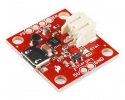c-scott
Member Since: January 28, 2010
Country: United States
-
A few typos: "resistorsl" -> "resistors", "regulator is dropping to voltage" => "regulator is dropping the voltage", in the optional teensy modification section you should probably note the size of the SMD resistor, and include it in the parts list, "Doublecheck" => "double check", "missle terminal" -> "middle terminal". The "final incremental test" section contains the text "...cap..." which presumably was meant to be a screen capture. It would be nice to have a clearer shot of the hole you drilled in the side for the USB programming jack, as well as the exact size of the hole. "AuroRoller" => "AutoRoller" (twice!), "sutoff" => "cutoff".
-
Yes, but you'll probably need a high current drive on that signal wire (aka, driving it directly from an arduino pin won't work).
-
No, it doesn't "fry this thing" -- at least not immediately. Vcc will be powered through an internal protection diode. It's still not a good idea to leave it in this condition indefinitely.
-
As I wrote, there's an internal protection diode which is powering Vcc for you, at a voltage drop of about 0.6V (which is what you are measuring). Although this works and won't damage the chip in the short term, it's not an idea long term because the internal protection diode isn't really meant for high currents.
Just connect Vcc to your microprocessor's power supply. "Heating up a lot" is what the driver is supposed to do when running a motor. If it wasn't heating up before, it probably wasn't actually turning the motor fully on.
-
If you care about power-down current, then it seems you should desolder R2 (the EN pullup) and replace it with your own circuit with a pulldown to ground and an active high. But that's not very beginner-friendly; it forces everyone to worry about the EN pin instead of supplying something which "just works" for most people.
So I agree with the logic of the circuit as provided, although I agree that the tutorial could be more explicit about the fact that "just" driving EN low isn't sufficient to minimize power draw. If they did a revision on the board, I'd suggest replacing the EN pad with a cuttable trace to the pull up resistor to make it clearer that, if you're thinking about driving EN, the first thing you need to do is disable the pull-up.
-
On the theory that at least some of the people visiting this page are looking for a diode with as little forward voltage drop as possible (for example, in a battery-powered project): there exist ICs which implement an "ideal diode" (that is, with extremely low voltage drop). For example: the LTC 4412 from Linear Technology, which has a nice digital output to tell you if its on battery power or not. It would be really nice if SparkFun would stock a breakout board for the LTC4412 or one of the other ideal diode ICs.
-
No datasheet with dimensions?
-
I'd double-check your wiring. Grounding the gate should turn off the LED strip. Raising the voltage above 2.5V should turn the LED strip on. Don't let the gate go above 20V.
The fact that the led strip is doing something in response to gate voltage changes would seem to indicate wiring error rather than a busted device. Usually letting the smoke out leads to solid-on or solid-off behavior in my experience.
-
Yes: use a pull-up/pull-down resistor to ensure that the gate is discharged. You should never let the gate of a FET-style device float. That stray capacitance picks up all sorts of things from the environment (RF, stray electric fields) and unpredictable things will happen in a circuit with a floating gate --- including destruction of the device in the worse case (stray electric fields can cause latch up, although this is not common).
-
Sounds like the right hook-up to me. Double check your "pin 1" etc against the datasheet. I find it easy to mix up the sides of this device. It's also possible there's static damage; MOSFETs are traditionally very sensitive to static. Modern devices aren't nearly as sensitive as in the "old days", though, and I've routinely handled MOSFETs with no special precautions without doing any damange. (And static damage tends to show up as a degradation of, eg, current-handling capacity, rather than a complete "shorted on" failure.)











